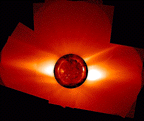 The SPARTAN 201
instruments
The SPARTAN 201
instruments The SPARTAN 201
instruments
The SPARTAN 201
instruments
The primary targets for the SPARTAN 201-3 flight of the Ultraviolet Coronal Spectrometer aboard SPARTAN 201 will be the north coronal hole and the boundary regions between coronal holes and streamers. Coronal holes are regions in the solar corona of exceptionally low density and temperature. Streamers are bright regions that are formed where the particles are trapped by the Sun's magnetic field. Temperature, density and velocity models for these regions will be determined using measurements of the atomic (neutral) hydrogen Lyman-alpha (H I 1216 Å) line profiles and the intensities of the ionized oxygen (O VI 1032/1037 Å) lines. They will provide an identification of solar wind source regions, while also mapping the sources of solar-wind streams detected by distant in situ measurements with the Smithsonian Astrophysical Observatory (SAO) in Cambridge, Massachusetts. The SPARTAN system was developed as a program in the Special Payloads Division of NASA Goddard Space Flight Center's Engineering Directorate.
The SPARTAN 201 coronagraph is the third in a series
of externally occulted coronagraph designs produced
by the
SPARTAN 201 White Light Coronagraph Parameters
Length: 2.63 m
Mass: Telescope: 47 kg
Electronics: 44 kg
Objective Lens: SMM backup achromatic coronagraph lens
with a 3.1 cm diameter and a 223 mm
focal length.
Central Operating Wavelength: 5200 Å
Filter Bandwidth 500 Å
Detector: RCA 256 x 320 pixel CCD
Image Scale: 22.5 arc seconds per pixel
Field of View: Offset field of view. Maximum height
limit is 6.0 solar radii, inner occulting
disk diameter of 1.25 solar radii.
Data rate: 19.2 kbit/sec
Exposure Times: 1 - 15 seconds
Calibration: External path injects filtered solar disk
light for calibration.
Polarimeter: Rotating half wave plate using a single
polarizer for minimizing instrumental
uncertainty.
Effective Data Rate: Approximately 30 images/55 minute orbit
or about 900 images/mission (including
calibration.
Well, what have we learned from this (so far)?
Some processed data from the first flight of SPARTAN 201 (on board STS-56) in
1993 April:
Text provided by Dr. Richard Fisher, NASA Goddard Space Flight Center; and Dr.
Leonard Strachan, Smithsonian Astrophysical Observatory.
This is the
access to this page since July 10, 1995.
![]() Return to the SPARTAN 201 home
page.
Return to the SPARTAN 201 home
page.